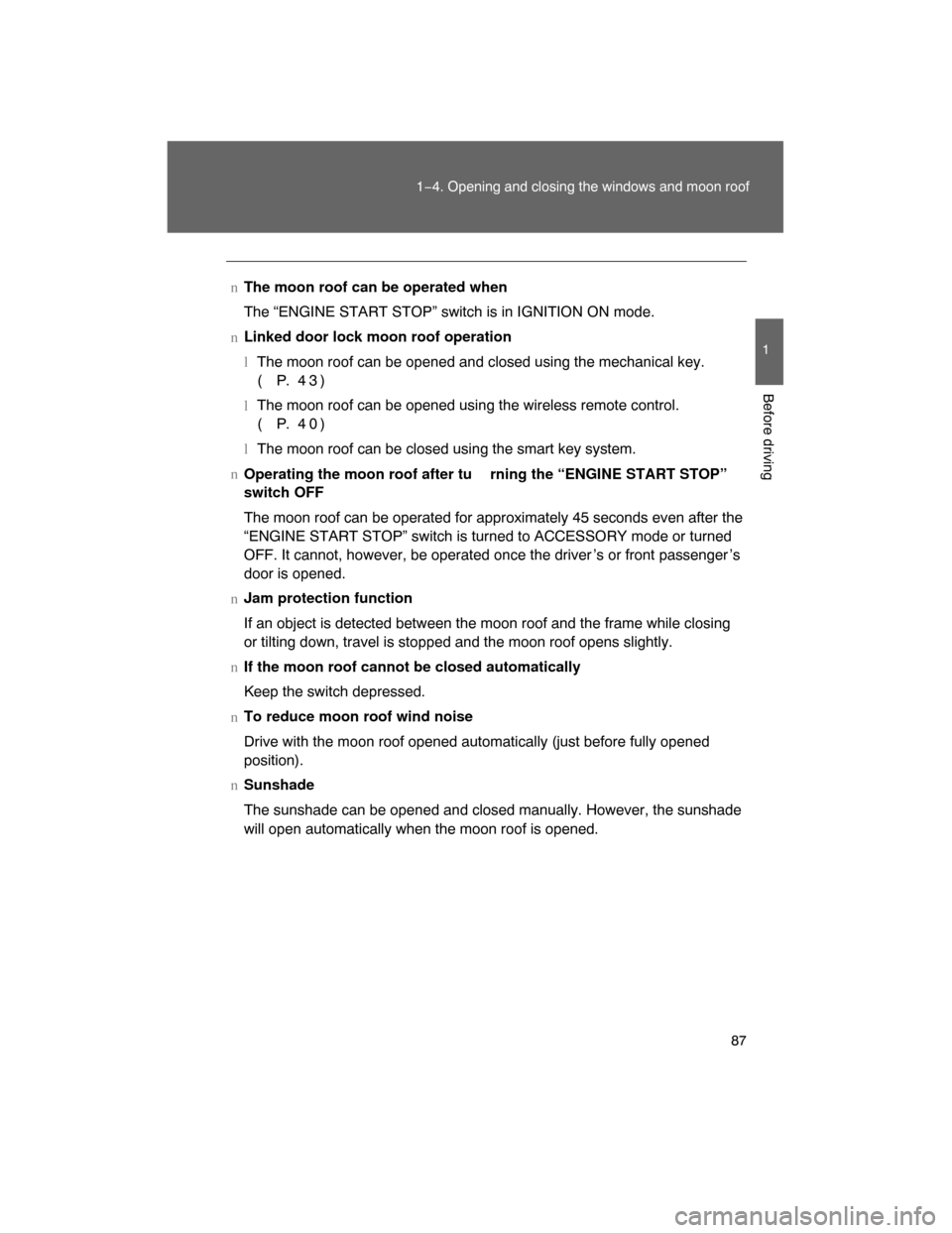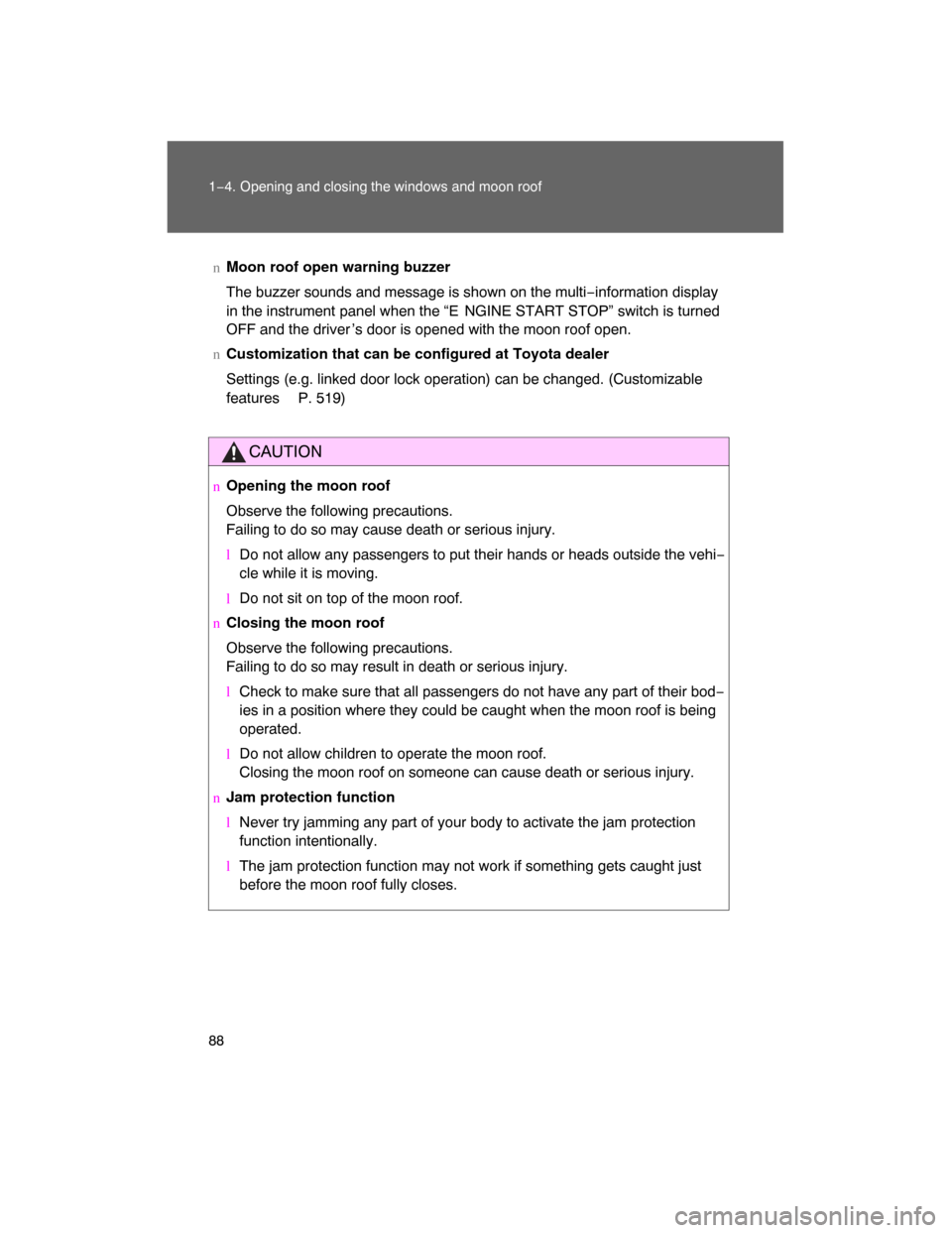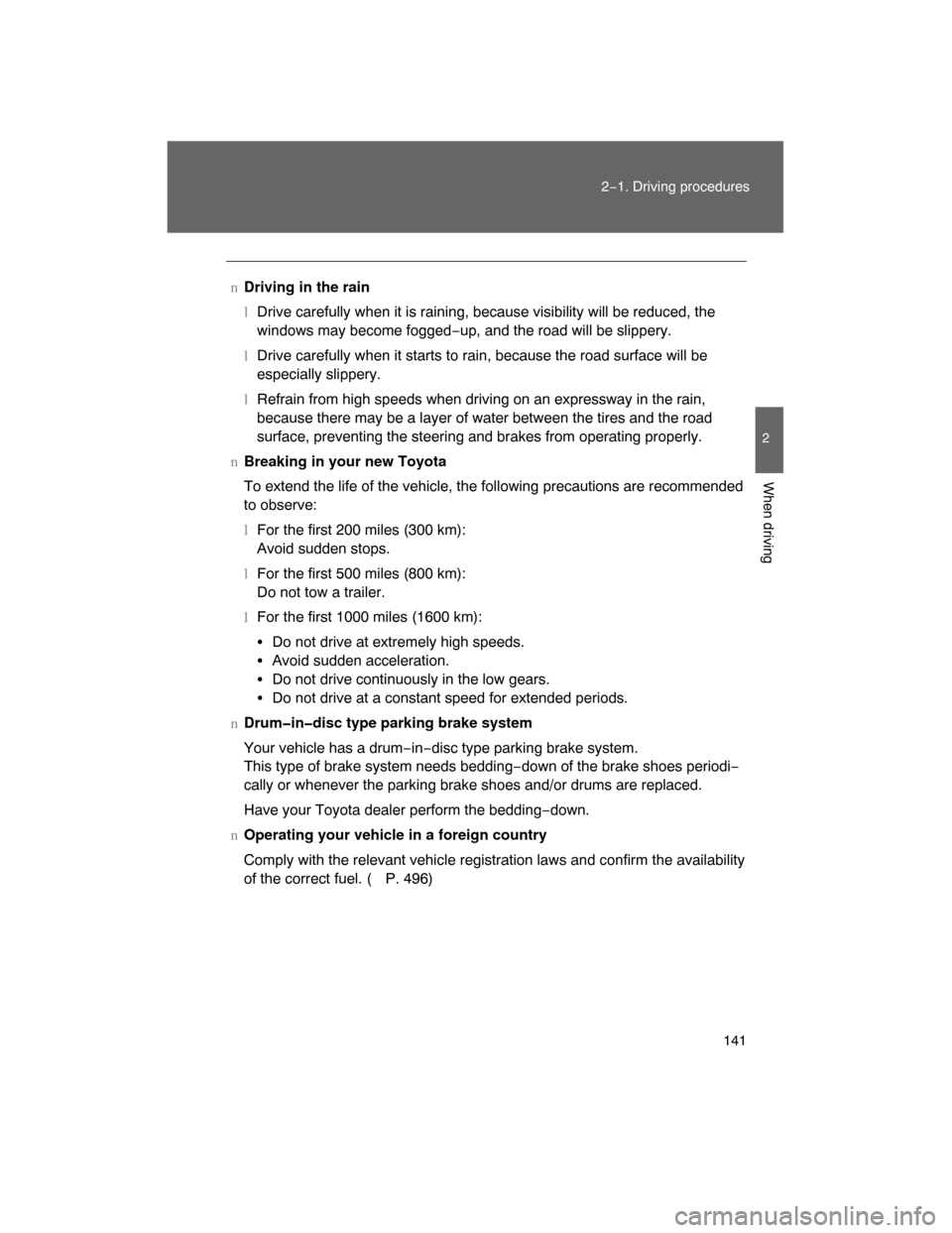Page 85 of 531
86
1−4. Opening and closing the windows and moon roof
Moon roof
Use the overhead switches to open, close, and tilt the moon roof up
and down.
nOpening and closing
Open
Stops just before it is opened
fully. Press the switch again to
fully open.
Close
To stop partway, press the
switch lightly.
nTilt up and down
Ti lt u p
Tilt down
To stop partway, press the
switch lightly.
Page 86 of 531

87
1−4. Opening and closing the windows and moon roof
1
Before driving
nThe moon roof can be operated when
The “ENGINE START STOP” switch is in IGNITION ON mode.
nLinked door lock moon roof operation
lThe moon roof can be opened and closed using the mechanical key.
(P. 43)
lThe moon roof can be opened using the wireless remote control.
(P. 40)
lThe moon roof can be closed using the smart key system.
n
Operating the moon roof after tu rning the “ENGINE START STOP”
switch OFF
The moon roof can be operated for approximately 45 seconds even after the
“ENGINE START STOP” switch is turned to ACCESSORY mode or turned
OFF. It cannot, however, be operated once the driver ’s or front passenger ’s
door is opened.
nJam protection function
If an object is detected between the moon roof and the frame while closing
or tilting down, travel is stopped and the moon roof opens slightly.
nIf the moon roof cannot be closed automatically
Keep the switch depressed.
nTo reduce moon roof wind noise
Drive with the moon roof opened automatically (just before fully opened
position).
nSunshade
The sunshade can be opened and closed manually. However, the sunshade
will open automatically when the moon roof is opened.
Page 87 of 531

88 1−4. Opening and closing the windows and moon roof
nMoon roof open warning buzzer
The buzzer sounds and message is shown on the multi−information display
in the instrument panel when the “E NGINE START STOP” switch is turned
OFF and the driver ’s door is opened with the moon roof open.
nCustomization that can be configured at Toyota dealer
Settings (e.g. linked door lock operation) can be changed. (Customizable
features
P. 519)
CAUTION
nOpening the moon roof
Observe the following precautions.
Failing to do so may cause death or serious injury.
lDo not allow any passengers to put their hands or heads outside the vehi−
cle while it is moving.
lDo not sit on top of the moon roof.
nClosing the moon roof
Observe the following precautions.
Failing to do so may result in death or serious injury.
lCheck to make sure that all passengers do not have any part of their bod−
ies in a position where they could be caught when the moon roof is being
operated.
lDo not allow children to operate the moon roof.
Closing the moon roof on someone can cause death or serious injury.
nJam protection function
lNever try jamming any part of your body to activate the jam protection
function intentionally.
l
The jam protection function may not work if something gets caught just
before the moon roof fully closes.
Page 88 of 531
89
1
Before driving
1−5. Refueling
Opening the fuel tank cap
Perform the following steps to open the fuel tank cap.
nBefore refueling the vehicle
Turn the “ENGINE START STOP” switch OFF and ensure that
all the doors and windows are closed.
n
Opening the fuel tank cap
Pull the lever.
Turn the fuel tank cap slowly
to open.
Hang the fuel tank cap on the
back of the fuel filler door.
STEP1
STEP 2
STEP 3
Page 97 of 531

98 1−6. Theft deterrent system
nItems to check before locking the vehicle
To prevent unexpected triggering of the alarm and vehicle theft, make sure
of the following.
lNobody is in the vehicle.
lThe windows and moon roof are closed before the alarm is set.
lNo valuables or other personal items are left in the vehicle.
nTriggering of the alarm
The alarm may be triggered in the following situations.
(Stopping the alarm deactivates the alarm system.)
lA person inside the vehicle opens a door or hood.
lThe battery is recharged or replaced when the vehicle is locked.
n
Panic mode
nDeactivating or stopping the alarm
Do one of the following to deactivate or stop the alarm.
lUnlock the doors using the smar t key system or the wireless
remote control.
lStart the engine. (The alarm will be deactivated or stopped after
a few seconds.)
When is pressed for longer than
about one second, the headlights/tail
lights/emergency flashers will flash, the
front and rear interior lights will come on,
and an alarm will sound for about 60 sec−
onds to deter any person from trying to
break into or damage your vehicle.
To stop the alarm, press any button on
the wireless remote control.
Page 113 of 531

114 1−7. Safety information
CAUTION
lIf the vinyl cover is put on the area where the SRS knee airbag will deploy,
be sure to remove it.
lDo not use seat accessories which cover the front seat as they may inter−
fere with inflation of the front passenger airbag.
lDo not use seat accessories which cover the parts where the SRS side
airbags inflate as they may interf
ere with inflation of the airbags.
lDo not strike or apply significant levels of force to the area of the SRS air−
bag components shown on P. 104. Doing so can cause the SRS airbags to
malfunction.
lDo not touch any of the component parts immediately after the SRS air−
bags have deployed (inflated) as they may be hot.
lIf breathing becomes difficult after the SRS airbag has deployed, open a
door or window to allow fresh air in, or leave the vehicle if it is safe to do
so. Wash off any residue as soon as possible to prevent skin irritation.
lIf the areas where the SRS airbags are stored, such as the steering wheel
pad and front pillar garnish, are dam
aged or cracked, have them replaced
by your Toyota dealer.
Page 139 of 531

141
2−1. Driving procedures
2
When driving
nDriving in the rain
lDrive carefully when it is raining, because visibility will be reduced, the
windows may become fogged−up, and the road will be slippery.
lDrive carefully when it starts to rain, because the road surface will be
especially slippery.
lRefrain from high speeds when driving on an expressway in the rain,
because there may be a layer of water between the tires and the road
surface, preventing the steering and brakes from operating properly.
nBreaking in your new Toyota
To extend the life of the vehicle, the following precautions are recommended
to observe:
lFor the first 200 miles (300 km):
Avoid sudden stops.
lFor the first 500 miles (800 km):
Do not tow a trailer.
lFor the first 1000 miles (1600 km):
�Do not drive at extremely high speeds.
�Avoid sudden acceleration.
�Do not drive continuously in the low gears.
�Do not drive at a constant speed for extended periods.
nDrum�in�disc type parking brake system
Your vehicle has a drum−in−disc type parking brake system.
This type of brake system needs bedding−down of the brake shoes periodi−
cally or whenever the parking brake shoes and/or drums are replaced.
Have your Toyota dealer perform the bedding−down.
nOperating your vehicle in a foreign country
Comply with the relevant vehicle registration laws and confirm the availability
of the correct fuel. ( P. 496)
Page 140 of 531

142 2−1. Driving procedures
CAUTION
nWhen starting the vehicle
Always keep your foot on the brake pedal while stopped with the engine run−
ning. This prevents the vehicle from creeping.
nWhen driving the vehicle
lDo not drive if you are unfamiliar with the location of the brake and accel−
erator pedals to avoid depressing the wrong pedal.
�Accidentally depressing the accelerator pedal instead of the brake
pedal will result in sudden acceleration that may lead to an accident
that could result in death or serious injury.
�When backing up, you may twist your body around, leading to a diffi−
culty in operating the pedals. Make sure to operate the pedals properly.
�Make sure to keep a correct driving posture even when moving the
vehicle only slightly, allowing you to depress the brake and accelerator
pedals properly.
�Depress the brake pedal using your right foot. Depressing the brake
pedal using your left foot may delay response in an emergency, result−
ing in an accident.
lDo not drive the vehicle over or stop the vehicle near flammable materials.
The exhaust system and exhaust gases can be extremely hot. This may
cause a fire if there is any flammable material nearby.
lDo not let the vehicle roll backwards while the shift lever is in a driving
position, or roll forward while the shift lever is in “R”.
Doing so may cause the engine to stall and lead to poor steering perfor−
mance, resulting in an accident or damage to the vehicle.
l
If the smell of exhaust is noticed inside the vehicle, open the windows and
check that the back door is closed.
Large amounts of exhaust in the vehicle can cause driver drowsiness and
an accident, resulting in death or a serious health hazard. Have the cause
of the problem inspected immediately.